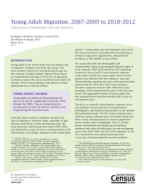Young Adult Migration: 2007–2009 to 2010–2012
Young Adult Migration: 2007–2009 to 2010–2012
Introduction
Young adults in the United States have the highest rate of migration compared with other age groups. The most common reasons for moving among all ages are job, housing, or family related.1 Many of these moves are made between the ages of 18 to 34, an age group marked by various life course transitions associated with moving.2 These include getting a job, going to college, getting married, or having children.
Generally, when economic conditions are good, the rate of migration is relatively stable, regardless of age.3 However, spurred by a credit and housing crisis, the Great Recession, which lasted from about 2007–2009, was followed by a large increase in unemployment in the United States. Accordingly, migration in the United States slowed.4,5 Young adults may have foregone many of the life course transitions associated with moving because of fewer employment opportunities, delayed family formation, or the inability to buy a home.
This report describes the demographic and socioeconomic status of young adult migrants, aged 18 to 34 using the 2007–2009 and 2010–2012 American Community Survey (ACS) 3-year estimates. Migrants in this report include any young adults whose current address was different from their address 1 year ago. These estimates represent the years of the postrecession period using the 2010–2012 ACS 3-year estimates and were compared with the 2007–2009 ACS 3-year estimates, which represented the years of the recession period. The geographic location of young adults was also analyzed for the two time periods with a focus on metropolitan areas.
The ACS is a nationally representative, ongoing survey that produces annual estimates of socioeconomic, demographic, and housing characteristics at the national and subnational levels. The ACS 3-year estimates are a multiyear dataset collected over a 36-month period that allow a more detailed analysis of smaller populations across smaller areas of geography. The U.S. Census Bureau recommends the comparison of multiyear estimates only when the data years are not overlapping, such as the 2007–2009 and 2010–2012 datasets.6 In the ACS, respondents were asked where they lived 1 year ago, which provided the previous residence (origin) information. The “residence 1 year ago” question was interpreted as a move in the last year despite the use of the 3-year datasets, rather than a move 3 years ago.7 The current residence information was obtained from the mailing address and the previous residence was self-reported. Age was reported at the time the survey was conducted.8
This report is organized as follows: first, there is an overview of migration trends across age groups, then each time period is examined—postrecession (2010–2012) and recession (2007–2009). For each time period, we examine the mobility trends for young migrants as well as their demographic and socioeconomic characteristics. Finally, there is an analysis of the geography of young inmovers by metropolitan areas.
Highlights
- Young adults had higher migration rates than the total population.
- The number of young adults who moved between the 2007–2009 recession period and the 2010–2012 postrecession period declined by about half of a million people.
- The migration rate of young adults declined about 1.4 percentage points from the 2007–2009 recession period to the 2010–2012 postrecession period.
- Young adults aged 18 to 24 had the highest migration rate compared to 25- to 29-year-olds and 30- to 34-year-olds in both the 2007–2009 recession period and the 2010–2012 postrecession period, and also had the largest decline from the 2007–2009 recession period to the 2010–2012 postrecession period.
- Young adult females aged 18 to 24 had a higher migration rate than young adult men 18 to 24 in the 2010–2012 postrecession period, while young adult males overall had larger declines between periods compared with women.
- Native-born young adults had larger declines between periods than the foreign born.
- Young adults with a college degree had the smallest declines in migration compared to young adults with less education.
- Many smaller metros, especially ones with colleges, had larger shares of young adult inmovers than large metro areas.
__________
1 David K. Ihrke, Carol S. Faber, and William K. Koerber, “Geographical Mobility: 2008 to 2009,” Current Population Reports, P20-565, U.S. Census Bureau, Washington DC, 2011.
2 Rachel S. Franklin, “Migration of the Young, Single, and College Educated: 1995 to 2000,” Census 2000 Special Reports, CENSR-12, U.S. Census Bureau, Washington, DC, 2003; and Justyna Gowrowkowska and Todd K. Gardner,“Historical Migration of the Young, Single, and College Educated: 1965 to 2000,” Population Division Working Paper No. 94, U.S. Census Bureau, Washington, DC, 2012.
3 David K. Ihrke, Carol S. Faber, and William K. Koerber, “Geographical Mobility: 2008 to 2009, Current Population Reports, P20-565, U.S. Census Bureau, Washington DC, 2011.
4 The Great Recession officially began in December of 2007 and ended in June of 2009, according to the National Bureau of Economic Research. See <www.nber.org/cycles.html>.
5 William H. Frey, The Great American Migration Slowdown: Regional and Metropolitan Dimensions, Brookings, Washington, DC, 2009; and David K. Ihrke, Carol S. Faber, and William K. Koerber, “Geographical Mobility: 2008 to 2009,” Current Population Reports, P20-565, U.S. Census Bureau, Washington DC, 2011.
6 See <www.census.gov/programs-surveys/acs/guidance/comparing-acs-data.html>.
7 For more information on how to interpret ACS multiyear data, see Section 11.11 at <www.census.gov/programs-surveys/acs/technical-documentation/summary-file-documentation.2014.html>.
8 All data include Puerto Rico, unless otherwise noted.
Related Documents
Others in Series
Publication
Publication
Publication







